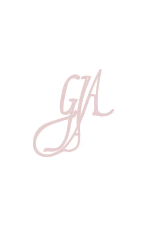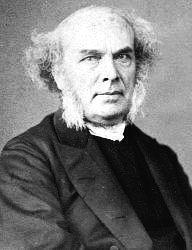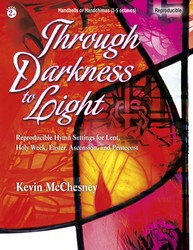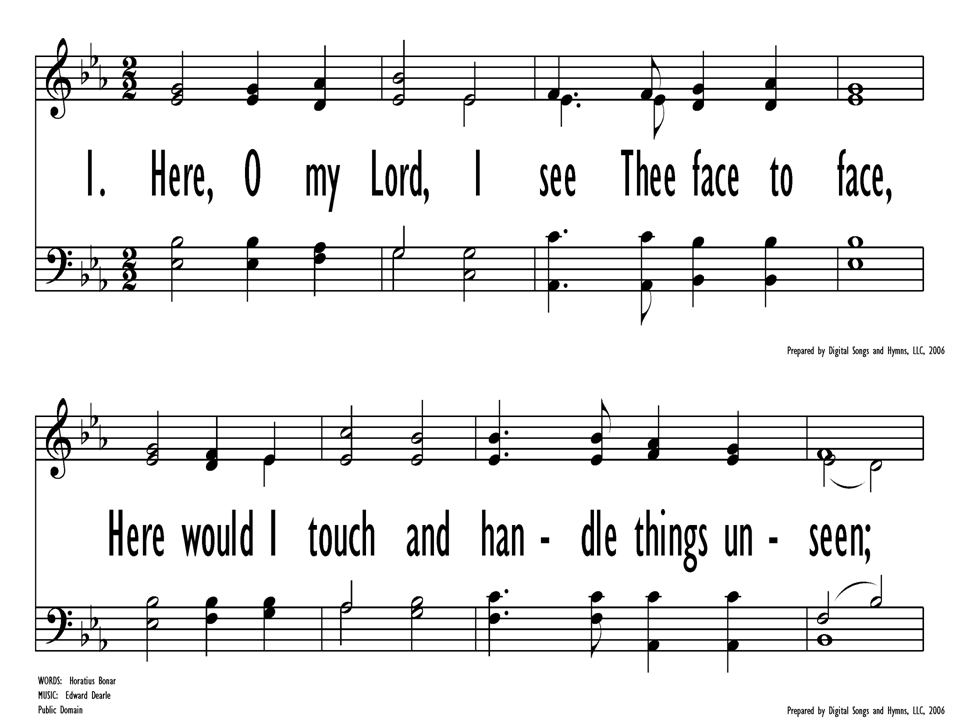Here, O my Lord, I see Thee face to face. H. Bonar. [Holy Communion.] Dr. H. Bonar's elder brother, Dr. John James Bonar, St. Andrew's Free Church, Greenock, is wont after each Communion, to print a memorandum of the various services, and a suitable hymn. After the Communion on the first Sunday of October, 1855, he asked his brother, Dr. H. Bonar, to furnish a hymn, and in a day or two received this hymn (possibly composed before), and it was then printed, with the memorandum, for the first time. It was published in Hymns of Faith and Hope, first series, 1857, in 10 stanzas of 4 lines, and headed, "This do in remembrance of me." In addition to being in extensive use in its original, or in an abridged but unaltered form, it is also given as:—
1. Here would I, Lord, behold Thee face to face, in Psalms & Hymns, Bedford, 1859, he.
2. Here, Lord, by faith I see Thee face to face, in Hatfield's Church Hymn Book, N. Y., 1872, &c.
3. Here, 0 my Lord, I humbly seek Thy face, in T. Darling's Hymns, &c, 1887.
4. And now we rise, the symbols disappear. Composed of stanzas v. and x. in the American Baptist Service of Song, Boston, 1871.
5. I have no help but Thine, nor do I need, in the Leeds Sunday School Hymn Book edition 1858.
In literary merit, earnestness, pathos, and popularity, this hymn ranks with the best of Dr. Bonar's compositions. [Rev. John Brownlie]
--John Julian, Dictionary of Hymnology (1907)
Notes
Here, O my Lord, I see Thee face to face. H. Bonar. [Holy Communion.] Dr. H. Bonar's elder brother, Dr. John James Bonar, St. Andrew's Free Church, Greenock, is wont after each Communion, to print a memorandum of the various services, and a suitable hymn. After the Communion on the first Sunday of October, 1855, he asked his brother, Dr. H. Bonar, to furnish a hymn, and in a day or two received this hymn (possibly composed before), and it was then printed, with the memorandum, for the first time. It was published in Hymns of Faith and Hope, first series, 1857, in 10 stanzas of 4 lines, and headed, "This do in remembrance of me." In addition to being in extensive use in its original, or in an abridged but unaltered form, it is also given as:—
1. Here would I, Lord, behold Thee face to face, in Psalms & Hymns, Bedford, 1859, he.
2. Here, Lord, by faith I see Thee face to face, in Hatfield's Church Hymn Book, N. Y., 1872, &c.
3. Here, 0 my Lord, I humbly seek Thy face, in T. Darling's Hymns, &c, 1887.
4. And now we rise, the symbols disappear. Composed of stanzas v. and x. in the American Baptist Service of Song, Boston, 1871.
5. I have no help but Thine, nor do I need, in the Leeds Sunday School Hymn Book edition 1858.
In literary merit, earnestness, pathos, and popularity, this hymn ranks with the best of Dr. Bonar's compositions. [Rev. John Brownlie]
--John Julian, Dictionary of Hymnology (1907)
Hymnary Pro Subscribers
Access
an additional article
on the Canterbury Dictionary of Hymnology:
Hymnary Pro subscribers have full access to the Canterbury Dictionary of Hymnology.
Subscribe now
Tune
LANGRANLANGRAN (also known as ST. AGNES) was composed by James Langran (b. London, England, 1835; d. London, 1909) and first published by Novello in a pamplet in 1861 as a setting for the hymn text "Abide with Me." Several other texts have also been set to the tune, which is one of Langran's best. Sing it…
Go to tune page >
MORECAMBEMORECAMBE was composed in 1870 by Frederick C. Atkinson (b. Norwich, England, 1841; d. East Dereham, England, 1896) as a setting for Henry Lyte's "Abide with Me" (442). It was first published in G. S. Barrett and E.J. Hopkins's Congregational Church Hymnal (1887). The tune is named for a coastal tow…
Go to tune page >
PENITENTIA (Dearle)

 My Starred Hymns
My Starred Hymns








